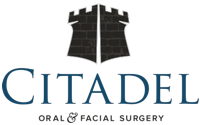Bone Grafting and Reconstruction
Over a period of time, the jawbone in the areas of missing teeth atrophies, or is resorbed. Sometimes a defect may be a result of some disease process, such as a jaw tumour that was surgically removed, from trauma, or because of a congenital defect such as cleft palate. This often leaves a condition in which there is poor quality and/or quantity of bone suitable for placement of dental implants or even dentures. Facial appearance and function may be compromised. In these situations, most patients are not candidates for treatment without prior reconstruction of the area.
Today, we have the ability to grow bone where needed. This not only gives us the opportunity to place implants of proper length and width, it also gives us a chance to restore functionality and esthetic appearance.
Major bone grafts are typically performed to repair larger defects of the jaws. These may arise as a result of severe bone atrophy, traumatic injuries, tumour surgery, or congenital defects. Large defects are typically repaired using the patient’s own bone. This bone is harvested from a number of different sites such as the jawbone, the front of back of the hip, the ribs, the skull, or the tibia (below the knee). These bone harvest sites are described below. The site depends on the size and nature of the defect. A short hospital stay is frequently chosen for major bone grafting cases depending on the complexity.
Minor bone grafts are usually sufficient to restore smaller defects, such as a single tooth implant site with inadequate bone structure due to previous extractions, gum disease or injury. The bone is often your own bone taken from the jaw most commonly, or sometimes from the hip or tibia. Frequently either a bone substitute (‘artificial bone’) or bone obtained from a tissue bank will be used as a replacement or a supplement to your own bone. In addition, special membranes may be utilized that dissolve under the gum and protect the bone graft and encourage bone regeneration. This is called guided bone regeneration or guided tissue regeneration. Most minor bone grafting can be done safely and efficiently in the office, though sometimes a hospital environment is used or even a short hospital stay is chosen.
Likewise, bone graft substitutes may be used. One has to understand that bone is a living tissue that undergoes constant growth and resorption, a process called remodeling. For this reason, each individual can sometimes have varying degrees of response to bone grafting, and the grafted bone may change and shrink with time.
Patient safety and success of the treatment are our goals, and all your options, including the benefits and risks of each, will be discussed with you during your consultation.
Bone Graft from the Jaws
In some cases, where a smaller amount of bone is required, bone could be obtained from the posterior mandibular region in the area of the wisdom teeth (often called a ‘ramus graft’), from the posterior part of the upper jaw behind the last molars (‘tuberosity graft’), or from the chin region. Bone is harvested and placed immediately to the required site where it is secured into place using small screws, which will be removed at a later date. This surgery is easily performed in the office, under either local anaesthesia or with I.V. sedation.
Tibial Bone Graft
Tibial bone graft is often used for sinus lift procedures, described below. A small incision is made over the top portion of the tibia, which is the ‘shin bone’ of the leg. The bone harvested from this area is packed and placed into desired sites. One can expect some discomfort at the surgical site for a period of days or sometimes a week or two, though walking is not restricted. This surgery can be done as an outpatient at a surgical facility.
Anterior or Posterior Iliac Crest (Hip Graft)
The grafted bone is often placed in either the maxilla or the mandible in order to increase the ridge height and width as well as increase the quality and quantity of bone, or used in the sinus lift procedure. Major jaw reconstruction also frequently entails this type of graft. These procedures may be done on an outpatient basis in a surgical facility, though are usually performed in a hospital. Sometimes a hospital stay of one or more nights is chosen depending on the situation.
The anterior iliac crest bone graft harvest is done via a small incision over the anterior portion of the pelvic bone above the hip. The bone is harvested from the medial aspect (the inside, towards the midline). The posterior iliac crest approach can obtain greater quantities of bone, useful in large reconstructions, but is somewhat more complicated to obtain because of having to turn the patient over. The incision is made far down on the lower back overlying the same bone as the anterior graft is taken from. Discomfort will be noted in the surgical region which will last anywhere between a few days to a few weeks. Other uncommon complications include bleeding, infection, numbness, or fracture.
Rib Graft
A rib graft, called a ‘costochondral graft’, is most often used for reconstruction of a temporomandibular joint (TMJ). The TMJs are the paired lower jaw joints in front of the ear of each side, and may need replacement due to advanced osteoarthritis, trauma, or disease. Rib can also be used for infraorbital reconstruction, nasal reconstruction as well as some areas of the mandible. The sequelae and complications of this surgical procedure are explained in detail during the consultation and the preoperative examination. Pneumothorax and altered skin sensation are two rare complications that can occur. This surgery is always done in a hospital as an inpatient.
Cranial Bone Graft
The lateral portion of the cranium, or skull bone, can be used in bony reconstruction of orbital rims or the nose, as well as certain portions of the maxilla. It is a far less common site for bone graft harvesting except in reconstruction following trauma or cancer surgery. This surgery is done in a hospital and requires an inpatient stay.
Bone Graft Substitutes
In certain cases it is acceptable or desired to use bone graft substitutes. These may be either actual bone tissue from human (homograft) or animal (xenograft) donors, treated to prevent infection or reactions, or artificial bone substitutes (allografts). There are many different types and brands available, each with some advantages and disadvantages. These ‘bone in a bottle’ options can often save the time, expense, and risk of harvesting your own bone. They are frequently used in conjunction with a graft of your own bone to augment the amount of bone and minimize how much needs to be taken from you. They cannot be used in all circumstances.
The maxillary sinuses are behind your cheeks and on top of the upper teeth. Sinuses are like empty rooms that have nothing in them. The bottom, or ‘floor’, of the maxillary sinus is indicated by the black arrows on this standard dental x-ray. Some of the roots of the natural upper teeth extend up into the maxillary sinuses. When these upper teeth are removed, there is often just a thin wall of bone separating the maxillary sinus and the mouth. Dental implants need bone to hold them in place. When the sinus wall is very thin, it is impossible to place dental implants in this bone.
There is a solution and it’s called a Sinus Graft or Sinus Lift. There are two techniques for the sinus lift, depending upon the amount of bone that needs to be enhanced. When a smaller enhancement is needed, the lift can be done with special instruments from within the preparation site for the implant. This is minimally invasive, and is called an indirect sinus lift When a larger augmentation is needed, the surgeon enters the sinus from the side through an incision and lifts the sinus lining (the membrane) up from the floor of the sinus. The donor bone or bone substitute, as described above under minor bone grafting, is then placed under the newly-elevated sinus lining allowing an implant to extend into this area.
If enough bone between the upper jaw ridge and the bottom of the sinus is available to stabilize the implant well, sinus augmentations and implant placement can sometimes be performed simultaneously as a single procedure. If not enough bone is available, the sinus augmentation will have to be performed first, then the graft will have to mature for several months, depending upon the type of graft material used. Once the graft has matured, the implants can be placed.
With the use of our i-CAT™ scanner, Citadel’s surgeons can visualize the anatomy in three dimensions and in most cases determine whether a sinus lift is required, whether the indirect or direct method is appropriate, and whether the implants can be placed simultaneously.
The sinus graft makes it possible for many patients to have dental implants when years ago there was no option other than wearing loose dentures.
The ridges are the areas of the jaw bone where teeth are supposed to be. In severe cases of maxillary (upper jaw) or mandibular (lower jaw) bone atrophy, the ridges have resorbed, or shrunk away, and bone grafting is required in order to increase the height and width of these areas. Techniques used to restore the loss of bone dimension in the jaw ridges include: onlay bone grafting, split ridge technique, and distraction osteogenesis of the alveolus. These procedures are typically done prior to the placement of dental implants. Depending upon the extent of the defect, either major or minor bone grafting may be used.
The inferior alveolar nerve, which gives feeling to the lower teeth, lower lip and chin, may need to be moved from its location inside the lower jaw bone (mandible) in order to make room for placement of dental implants. This procedure is limited to the mandible and may be indicated when teeth are missing in the area of the back teeth on either side. It is more commonly required following extended periods of missing teeth in this region due to advanced atrophy of the bone.
This procedure is performed through an incision on the inside of your mouth and requires cutting some of the cheek-side of the mandible and manipulation the nerve and blood vessel that run inside it to move them laterally out of the way. The implants may then be placed and the nerve allowed to lie back in the jaw. It will result in swelling and discomfort to a similar nature and extent as having impacted wisdom teeth removed. Since this procedure is considered a somewhat aggressive approach (there is almost always some postoperative numbness of the lower lip and jaw area, which carries a risk of being permanent) usually other, less aggressive options are considered first.
This principle developed many years ago by an orthopedic surgeon named Ilizarov, creates an increase in the dimensions of a bone by slowly separating (distracting) the segments. The highly specialized device is surgically placed first, in the area to be augmented within the mouth. Then following a short period for initial healing the device is activated by small amounts each day, separating the bone by 0.5 to 1 mm per day to increase the overall size of the bone. Once complete, the device is left in place for several weeks to allow definitive healing, then removed. This state-of-the-art technique may result in a larger augmentation than what is felt to be possible with standard bone grafting, and may have a longer-lasting result, all while avoiding the need to harvest bone from elsewhere in the body. It requires a longer treatment time and optimal patient cooperation and monitoring to have success, and is not indicated in all situations.
Please review our section on post-operative instructions.

